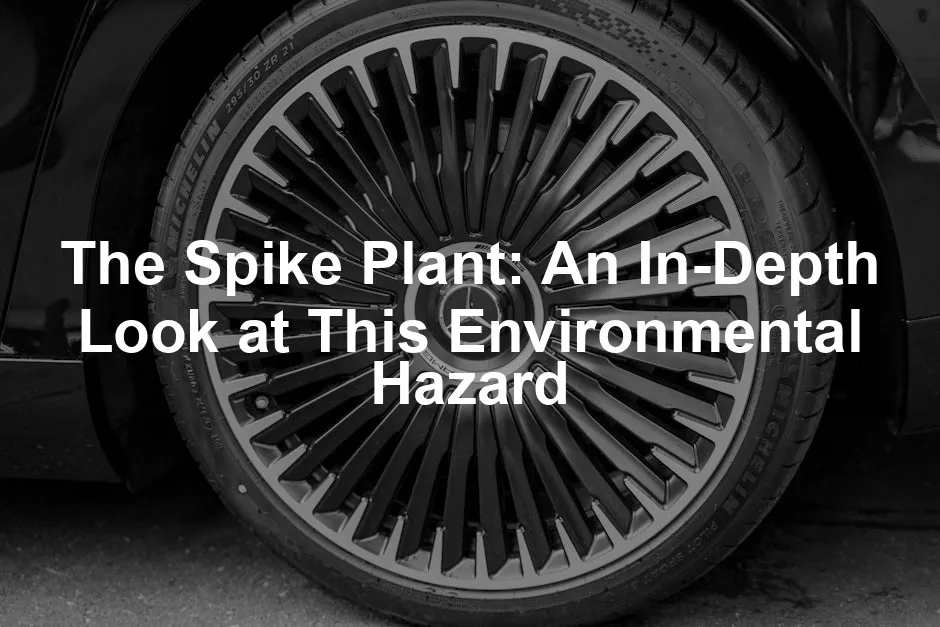

The Spike Plant: An In-Depth Look at This Environmental Hazard
Introduction
Have you encountered the Spike Plant in your gaming adventures? This peculiar green weed presents a unique challenge. With its long, gnarly stem and spiky balls, it poses a serious threat to creatures nearby. In this section, we’ll explore the Spike Plant’s features, its impact on the environment, and where you can find it. Let’s jump into the intriguing world of this environmental hazard!
Speaking of plants, if you want to deepen your knowledge about houseplants, check out “The Plant Lover’s Guide to Houseplants” by Scott McGillivray. This book is your ultimate companion for nurturing your indoor jungle and ensuring your houseplants thrive.

Summary and Overview
The Spike Plant is an environmental hazard that can change gameplay dynamics significantly. It features a distinctive appearance characterized by a long, twisting stem topped with multiple green spiky balls. This plant is not just for show; it plays a crucial role in its ecosystem by affecting creature movement and stamina.
As a hazard, the Spike Plant slows down nearby creatures, draining their stamina and dealing damage. Its presence can alter strategies in gameplay, forcing players to adapt to its dangerous effects. You’ll commonly find Spike Plants in challenging biomes such as the Nuclear Wasteland, Mystic Forest, and Volcanic Jungle. Understanding the Spike Plant’s characteristics and locations can enhance your gameplay experience.
And for those who prefer virtual gardening, don’t miss the fun of “Plants vs. Zombies” Game. It’s a hilarious way to fend off zombies with your favorite plants while strategizing your way to victory!
Environmental hazards like this one add depth to gaming mechanics. Studies show that these elements enhance engagement and challenge. In real life, plants similar to the Spike Plant contribute to their ecosystems by providing shelter and food for various species. So, are you ready to learn more about the intricacies of the Spike Plant? Let’s dive deeper into its characteristics!

Characteristics of the Spike Plant
The Spike Plant stands out with its unique physical traits. Its long, twisted stem is quite noticeable, often bending under its own weight. At the top, it boasts multiple green spiky balls, resembling clusters of miniature grenades. These spikes aren’t just for show; they serve a purpose in the game’s ecosystem.
When you look closer, you’ll notice the texture of the Spike Plant is rough and prickly. Its vibrant green color adds to its threatening appearance. This plant is classified as an environmental hazard, meaning it significantly impacts gameplay.
For those interested in understanding more about plant care, consider picking up “The Ultimate Guide to Houseplants” Book. This book is perfect for beginners and seasoned plant parents alike, offering tips on everything from watering to pest control!
In terms of growth patterns, the Spike Plant thrives in challenging conditions. It often spreads rapidly, allowing it to dominate certain areas. Reproduction occurs through the dispersal of its spikes, which can embed themselves in the ground to grow new plants.
Players may find similarities between the Spike Plant and real-life thorny plants, such as the thistle. Just like in nature, this plant’s spiky defenses deter most creatures. In game design, such features add realism and depth, making encounters more exhilarating.
Have you faced the Spike Plant in your gaming experience? Share your stories and strategies in the comments below!

Detailed Attack Statistics
The Spike Plant packs a punch with its unique attack mechanics. Let’s break down its attack statistics to understand how it can affect gameplay.
Projectile Caliber and Mass
The Spike Plant fires projectiles with a caliber of 15 mm. Each spike weighs about 100 grams, making them hefty enough to cause significant damage. This mass contributes to the inertia of the projectiles, allowing them to hit with force.

Initial Velocity and Drag Factors
These spikes launch at an initial velocity of 35 meters per second. However, they face a drag factor of 50%. This drag slows them down as they travel. Additionally, gravity has a full effect on them, ensuring they fall over time. This combination affects how players should approach or evade the plant.
Damage Statistics and Area of Effect
The Spike Plant delivers a standard damage of 65 to nearby creatures. This damage remains constant, even against more durable foes. Upon explosion, it releases shrapnel, creating an area of effect. The inner radius for maximum damage reaches 2 meters, dealing 100 damage. Outside this zone, damage tapers off but can still reach up to 99 depending on the distance.

If you’re looking to enhance your gardening skills even further, consider reading “The Complete Book of Edible Landscaping” by Rosalind Creasy. This book is a delightful guide for anyone looking to create a beautiful garden that’s also delicious!
Damage Types
The Spike Plant’s damage varies based on the angle of impact. At direct hits, it inflicts light penetration damage. When hit at slight angles, it also results in light damage. However, at larger or extreme angles, the damage shifts to “Unarmored II,” indicating a more significant impact on unarmored targets.
Special Effects
Beyond direct damage, the Spike Plant can create chaos in its vicinity. Its demolition force measures 10, which can destroy nearby objects. The stagger force is 25, making it effective at disorienting creatures. Additionally, the push force of 25 can knock back enemies, creating strategic opportunities for players.

Comparative Statistics
When compared to other environmental hazards, the Spike Plant stands out. Its damage output and area of effect are notable, particularly in biomes where players face multiple hazards. Understanding these statistics is crucial for players looking to develop effective strategies against the Spike Plant. For more information on enhancing your gameplay through companion planting strategies for increased yield, check out our related article.
Understanding effective strategies can significantly improve your gameplay experience. Companion planting strategies for increased yield can offer valuable insights.
Are you ready to rethink your tactics? Analyze these statistics to enhance your approach against the Spike Plant and share your strategies below!

Change History of the Spike Plant
The Spike Plant has undergone several notable changes through various game patches. These updates have affected its behavior, damage output, and overall interactions within the game. Understanding these adjustments can help players adapt their strategies effectively.
One significant update occurred in Patch 1.000.400, released on June 13, 2024. This patch brought about major changes. The Spike Plant no longer inflicts bleed or stamina drain when players are hit by its explosions or spikes. This alteration can significantly change how players approach encounters with the plant.

Additionally, this patch introduced a new mechanic where the Spike Plant now “pops” three times. With each pop, it releases spikes in all directions, increasing its damage potential. This change encourages players to rethink their tactics, as proximity to the plant can result in rapid damage from multiple angles.
Player feedback has noted that these adjustments create a more dynamic challenge. Players have expressed appreciation for the balance changes, as they make the plant less punishing while still retaining its hazardous nature. These insights highlight the significance of ongoing game updates in shaping player experiences.
For those who are curious about the broader world of plants, consider picking up “The Natural History of the Garden” Book. It’s a fascinating read that dives into the relationship between nature and gardening!
How have these changes affected your strategies? Share your thoughts below!

Conclusion
In summary, the Spike Plant remains a formidable environmental hazard. Its changes through various patches have influenced gameplay and player strategies. Understanding these updates is essential for navigating encounters effectively. The Spike Plant’s ability to alter movement and deal damage makes it a crucial element in the game’s ecosystem.
We encourage players to engage with this content and share their experiences with the Spike Plant. Your insights can help fellow gamers adapt and thrive in the game!

If you’re interested in keeping track of your plant’s health, a Houseplant Journal can be a great addition to your gardening toolkit!
FAQs
What is a Spike Plant in gaming?
The Spike Plant is a unique environmental hazard. It features a long, gnarly stem topped with spiky balls. This plant can impede player movement and drain stamina. Players encountering it must adapt quickly to avoid damage. Its role adds tension and strategy to gameplay.
How does the Spike Plant affect players?
When players approach the Spike Plant, they experience slowed movement. This plant drains stamina, making it harder to escape. Additionally, if players come too close, they take damage. These mechanics create challenges, forcing players to rethink their strategies and movements.
Where can I find the Spike Plant?
You can find the Spike Plant in various biomes. Look for it in the Nuclear Wasteland, Mystic Forest, and Volcanic Jungle. Each biome offers unique challenges and features. To locate them, explore these areas and be mindful of their distinct environmental traits.
Are there strategies to avoid the Spike Plant’s effects?
Players can use several tactics to navigate around the Spike Plant. Keeping a safe distance helps avoid damage. Use ranged attacks when possible to eliminate the plant from afar. Also, be quick on your feet! Staying mobile can help you evade its effects during intense encounters.
What changes have been made to the Spike Plant in recent patches?
Recent patches have introduced significant changes to the Spike Plant. For example, a patch removed bleed and stamina drain effects from its attacks. Moreover, the plant now “pops” multiple times, releasing spikes in all directions. These updates impact player strategies, encouraging new approaches to encounters.
Please let us know what you think about our content by leaving a comment down below!
Thank you for reading till here 🙂
All images from Pexels



